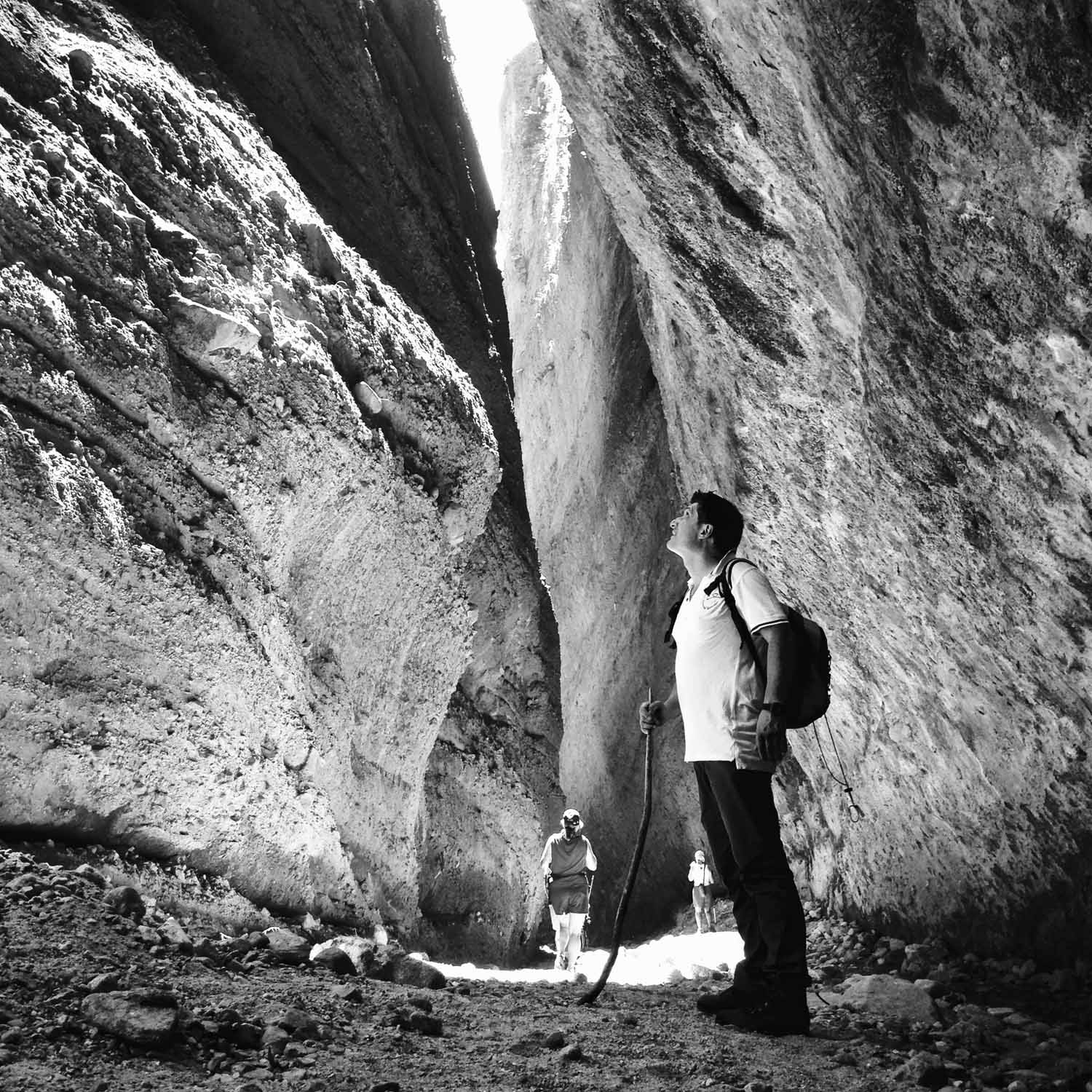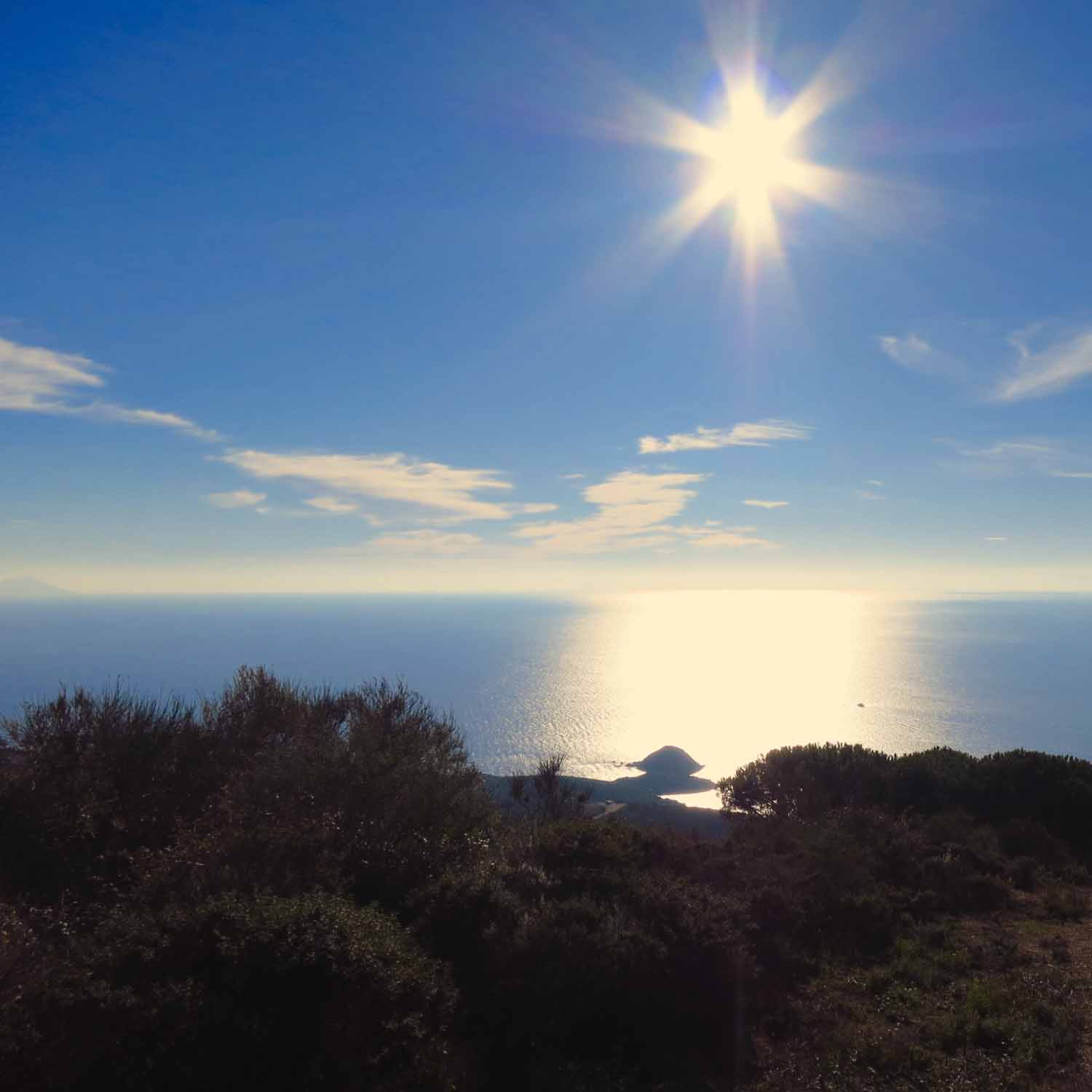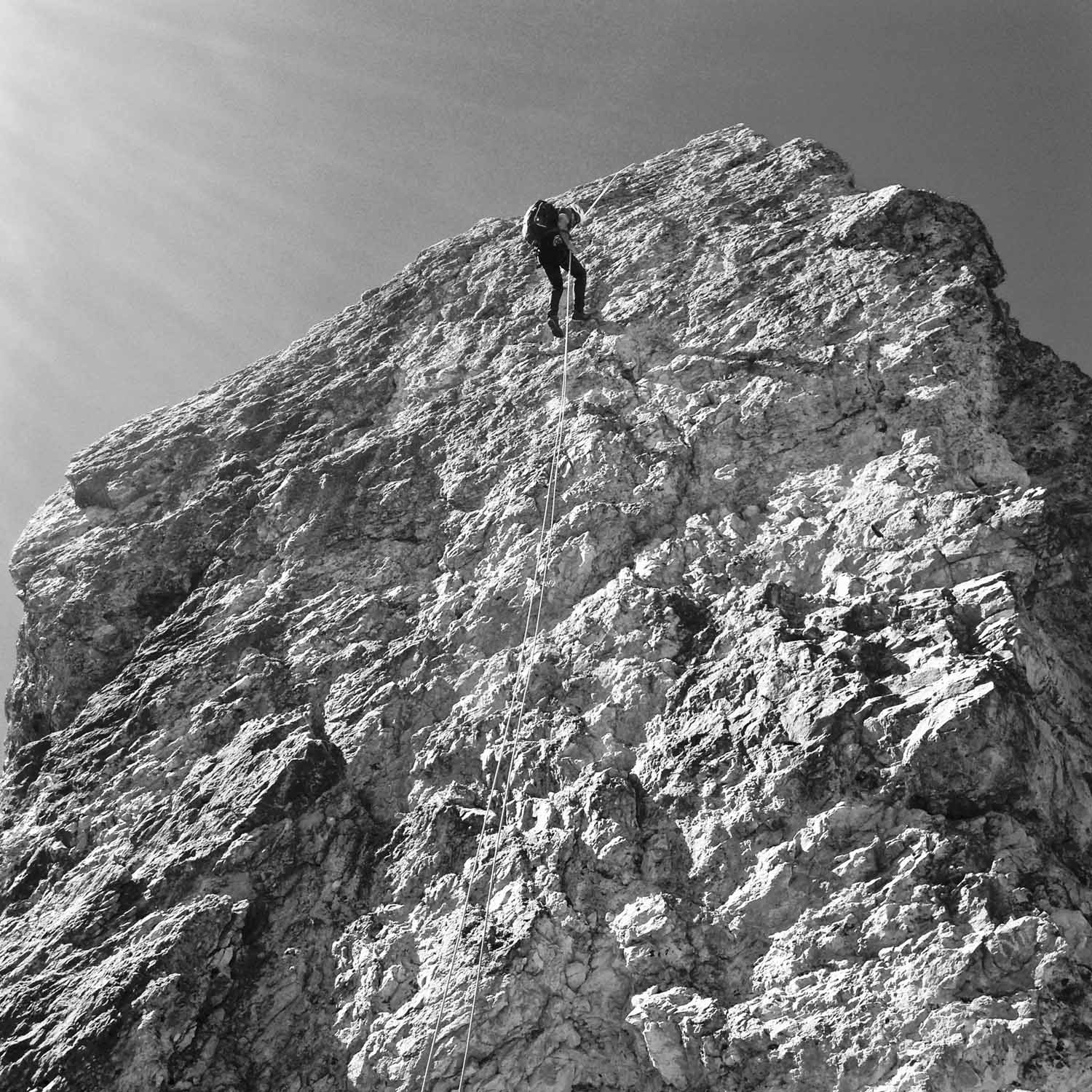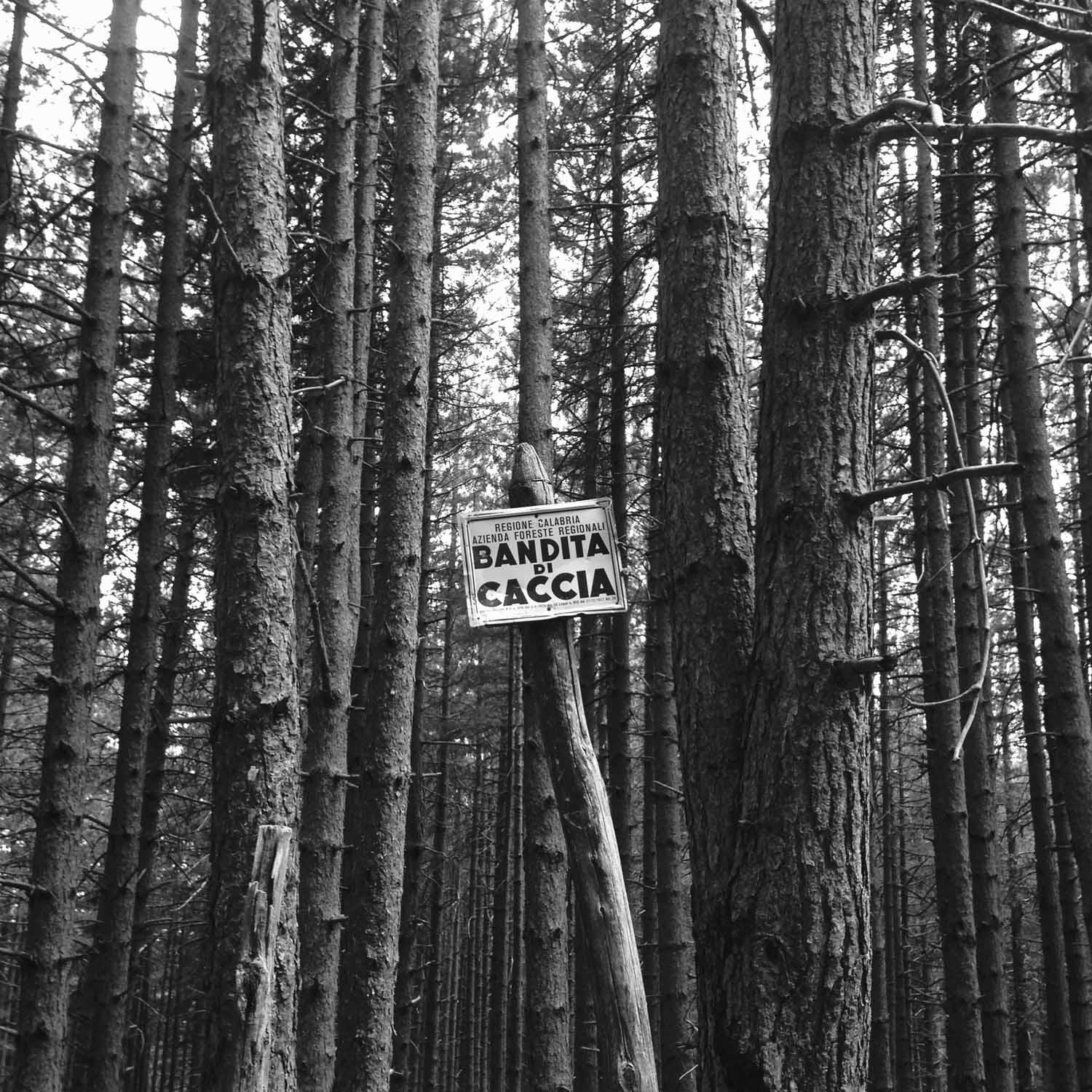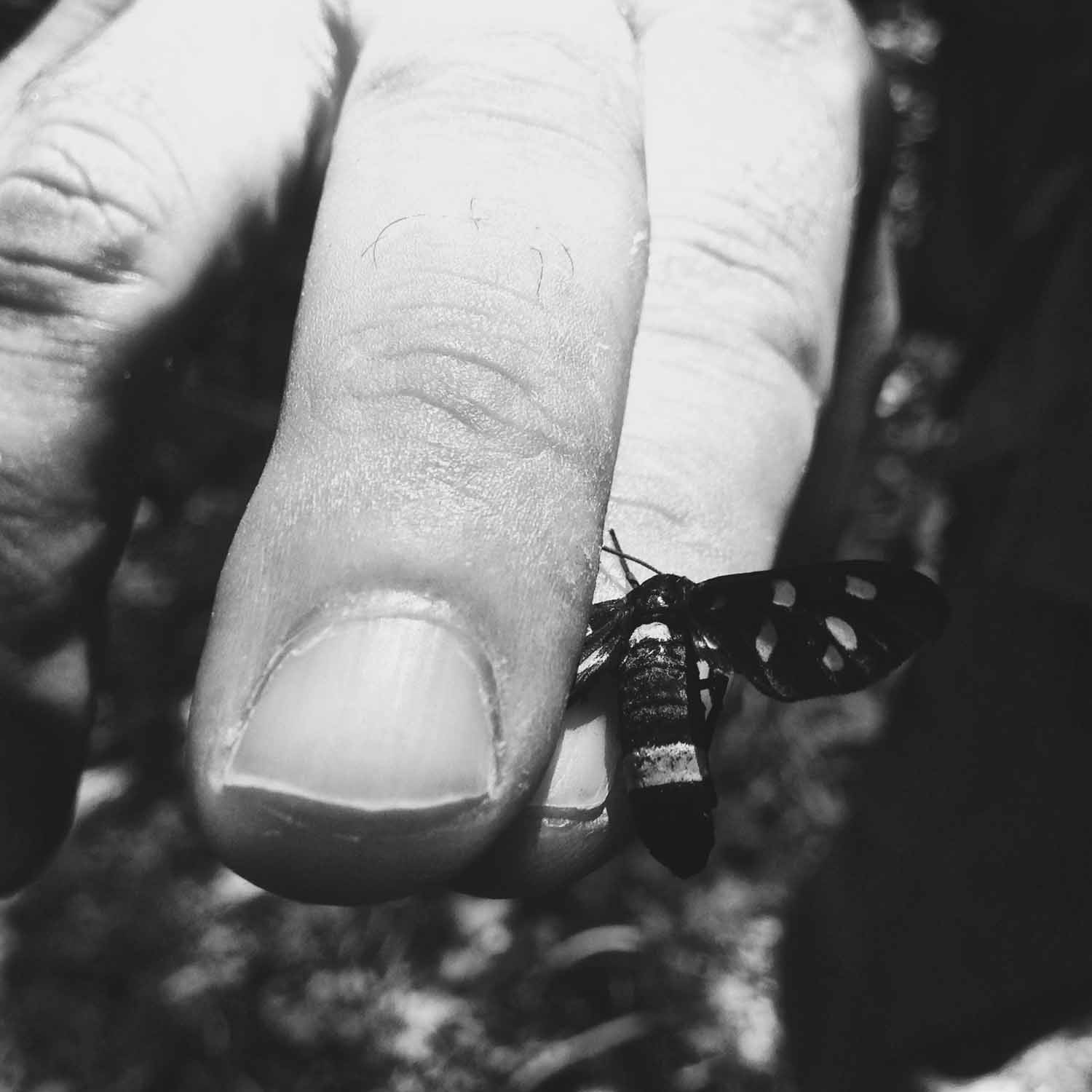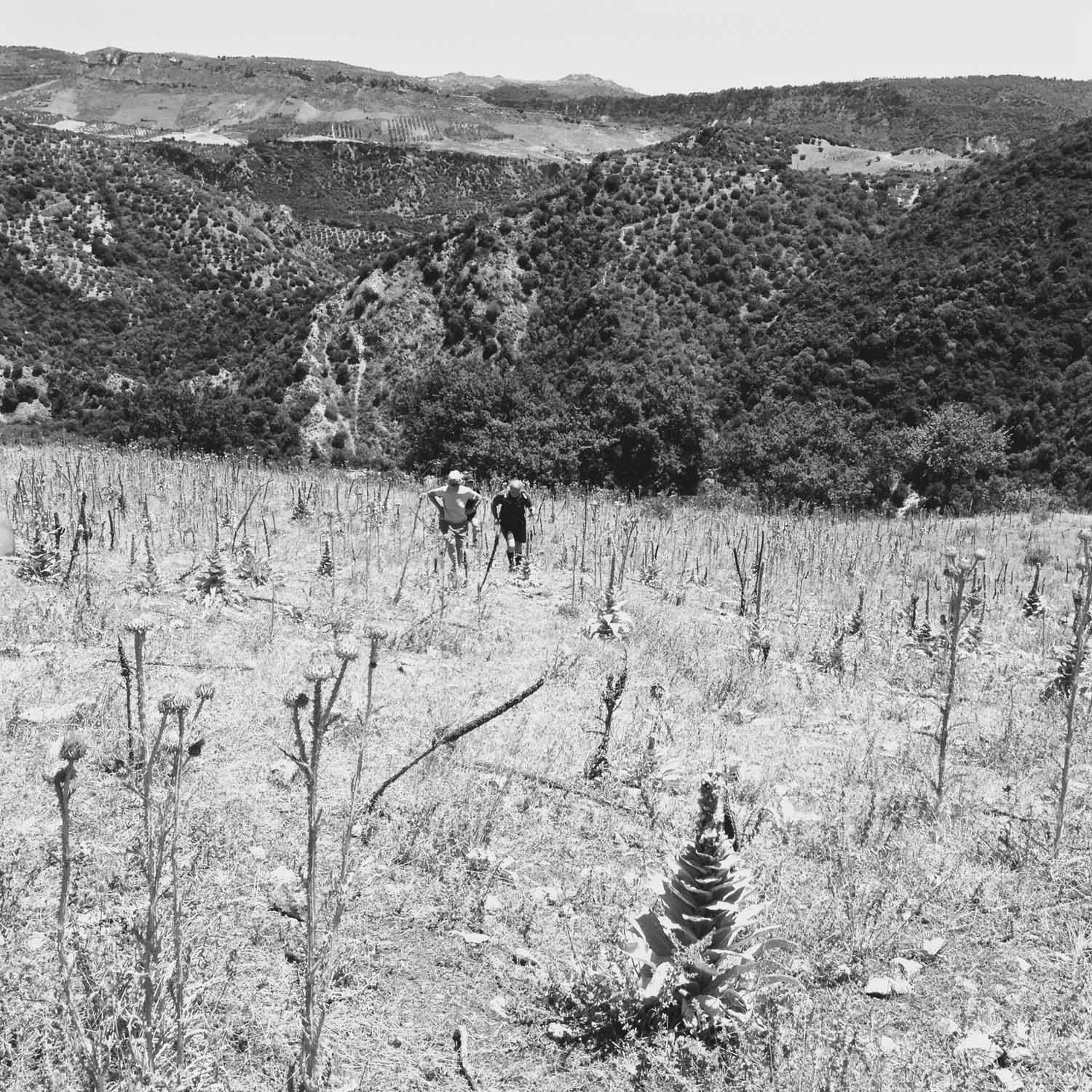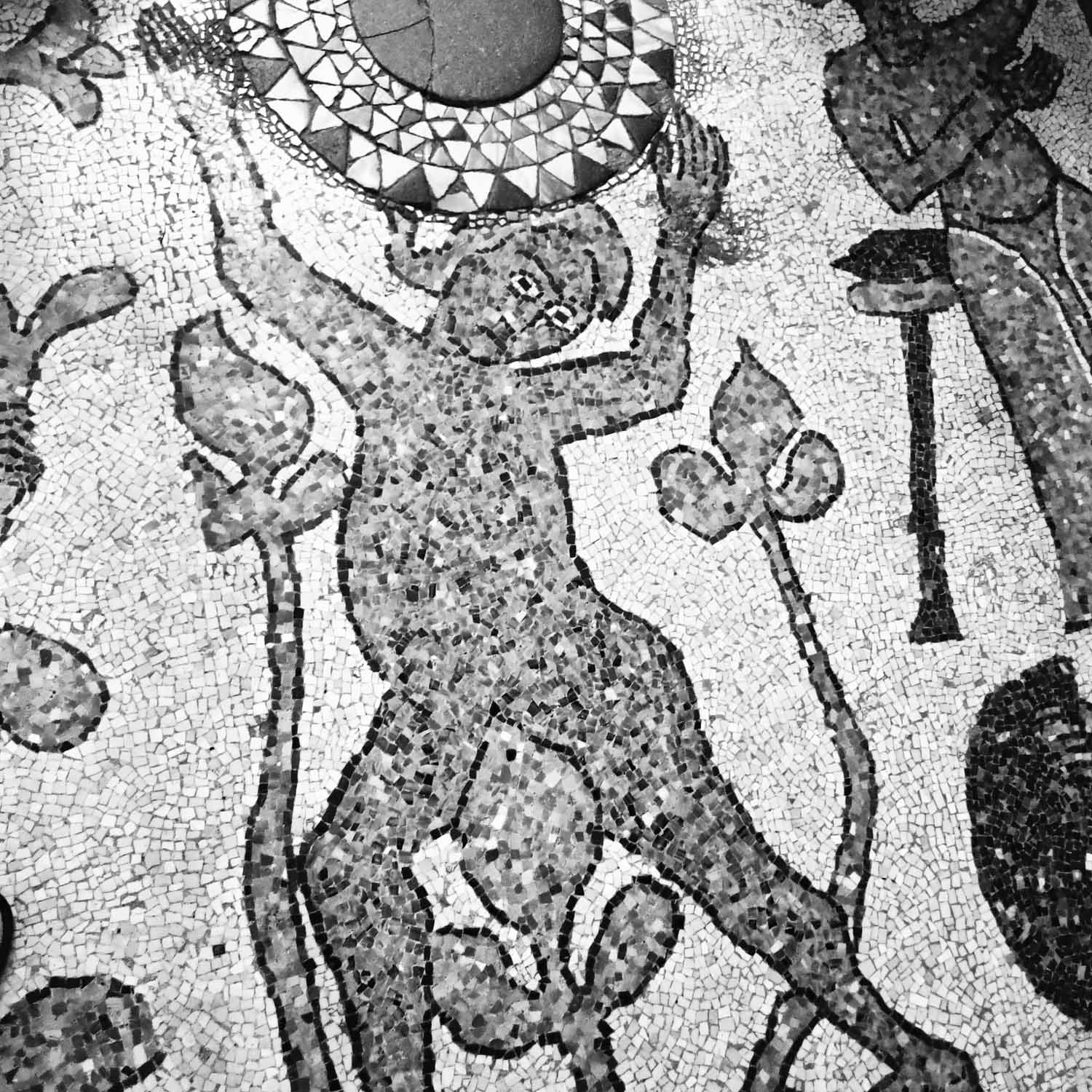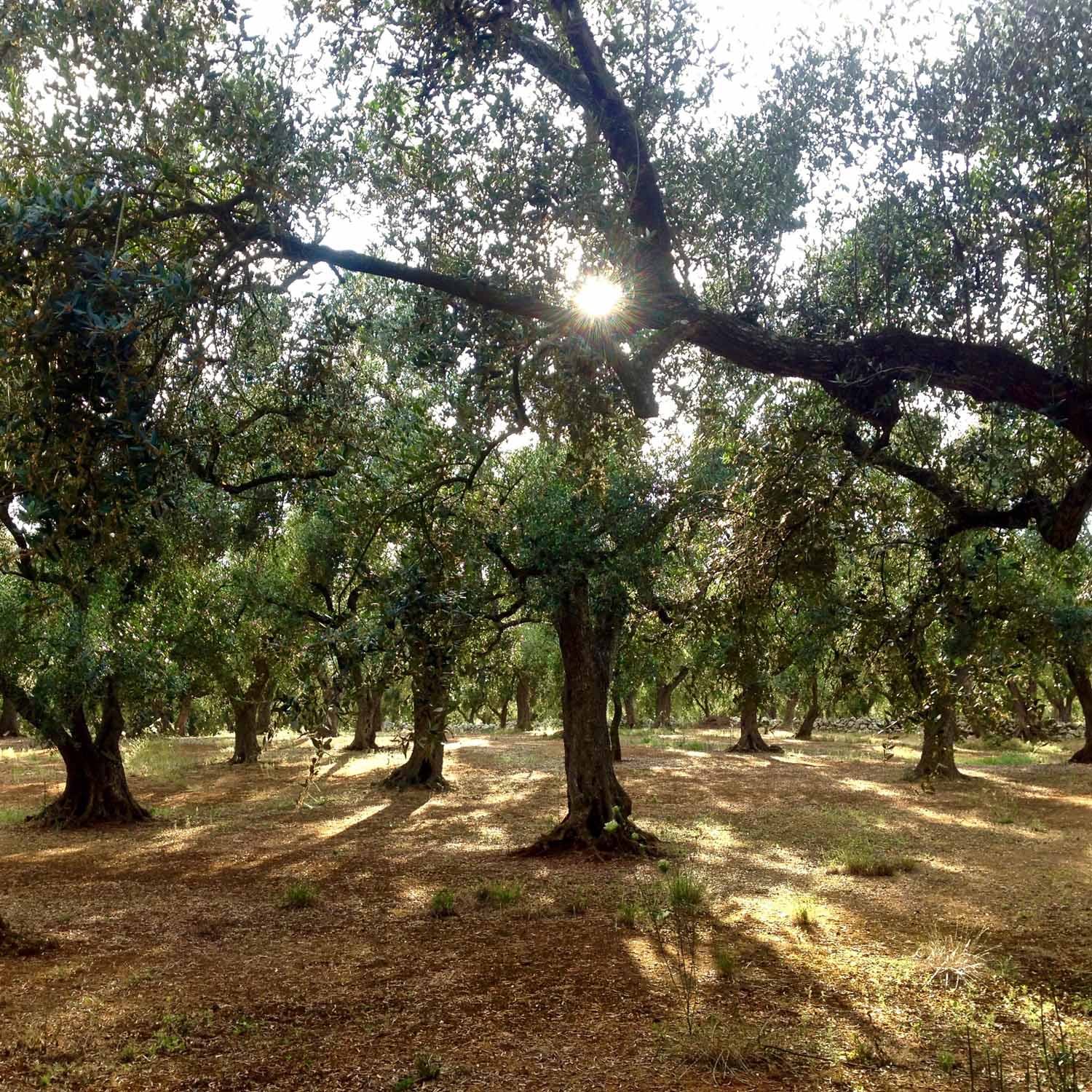A Grand Calabrian Canyon (Sila Walk/Day 7)
A Grand Calabrian Canyon [Day 7]
by Rudston Steward
e had hiked for five days straight across the Sila plateau, immersed in its ancient forests. The abrupt change of scenery that came next, on Day 6, was shocking: a showstopping descent into the arid canyons of the Valli Cupe.
I’d never heard of the Valli Cupe before. What an odd name, I thought—the Gloomy Valleys. It sounded ominous, and a bit dull. I steeled myself for disappointment—the splendor of the five walks thus far, ensconced in our canopy of green, was bound to end sooner or later. We’d had a great run.
I fortified myself with multiple rounds of espresso, and took heart from the solid hunk of capocollo (cured pork shoulder) I’d seen our guide Francesco slip into his backpack for our lunch. Then we were off, across Sersale’s piazza, down the main street. On the outskirts of town a track branched off towards Monte Crozze, rounding its flank to a saddle. Views opened up towards the coast: a palette of colours shading from emerald velvet green—the Sila forest above and behind us—to the tuffaceous pink of rocky hillsides sloping away below, and, approaching the sea, a salt-and-pepper patchwork of ochre fields and olive greys. Lengthways, slicing diagonally across our landscape-canvas, ran a series of deep narrow gashes, geomorphic scars sunken into the earth: the gloomy valleys, in the flesh.
We scrambled over a lip and down into a dry stream-bed. It started out as a shallow valley, the upper reaches of its flanks wooded and green, holm oak interspersed with macchia scrub. But as we dropped further the bed got narrower, the walls steeper. The vegetation morphed as we entered a distinct and self-contained biotope. Ferns now clung to the slopes, a fuzz of pale grass dangled in clumps from strata of sand and gravel.
I WAS BEING SUCKED GRADUALLY DOWN A VAST MEGALITHIC CHUTE, PULLED AHEAD BY SOME FATAL ROCKY ATTRACTION.
The sides of the gorge rose almost vertically above us, so that the light reflecting down became murky and refracted. I could hear the patter of my footfall on rock echoing overhead, scurrying upwards. It felt like I was being sucked gradually down a vast megalithic chute, pulled ahead by some fatal rocky attraction.
The final, climactic stretch of canyon narrowed to just a few meters wide, the track now gritty underfoot, with sheer cliff-faces twisting up and away on either side. Sunlight insinuated itself into the gap above, reflecting off the striations of rock and sediment, taking on a mineral radiance as it bounced its way down. At the bottom we basked in its stunning geological glow.
I walked entranced, humbled by the unexpected magnificence of this Grand Calabrian Canyon.
Then we emerged, abruptly. The gorge opened up, cliffs falling away to a gentler gradient, the track widening onto a flat riverbed. We stopped under a eucalyptus tree to devour our capocollo, deftly carved up by Francesco, and continued on, uphill again, through scorching fields towards the town of Cropani.
I didn’t say much the rest of the way. The canyon trance stayed with me, all the way to Cropani and beyond. And I’ve been actively plotting my return to the Valli Cupe ever since - it is one of the most remarkable places I’ve had the good fortune of stumbling upon (or, in this case, of stumbling down, rapt in a geological trance) on my Italian Odyssey thus far.
Montecristo, Island Outlier
Montecristo, Island Outlier
by Rudston Steward
very archipelago worth its sea-salt has an outlier island, set apart from the rest. It usually floats on the periphery, harder to reach than the others; more remote, less visited, more intriguing. Outlier islands are shrouded in mystery, cooler-than-thou, exerting irresistible island-hopping attraction.
The Aeolian Islands have Alicudi: a lone volcanic cone cast poetically adrift on the Tyrrhenian sea. In the Egadi Islands there’s Marettimo, the wild and wayward wedge of green deep off Sicily’s western coast. Sardinia's Maddalena Archipelago has Spargi—a low-lying aquatic jewel idling almost unnoticed beyond the close-cropped glare of the day-trippers.
But the ultimate Mediterranean outlier, without a doubt, holds sway in the Tuscan Archipelago: the phantasmagoric island of Montecristo. An enticing apparition suspended between the Italian peninsula and Corsica, Montecristo is tantalizingly off-limits. It is extremely difficult to visit—only 1000 people per year are allowed on its protected shores, and trips are booked up years in advance.
The island is uninhabited, starkly beautiful, a precious refuge for endemic and exotic wildlife. And it has a swashbuckling literary pedigree to boot, the romantic stuff of Counts and pirate treasures and Napoleonic revenge. All told Montecristo cries out for exploration, for travel.
And yet I’ve never been to Montecristo, and will probably never go.
Why? Because some destinations are rendered more alluring precisely because we never visit them. They get to hover indefinitely on the outer fringes of our imagination, beguiling, their mystique intact.
We live in a world, it often seems, where nothing is beyond our reach anymore. In travel that's not necessarily a good thing. The mystical nooks and crannies—like Montecristo—are increasingly accessible, laid bare, often unceremoniously, before our prying eyes.
In my opinion some magical travelling stones are these days better left unturned.
Adagio Falzarego
Adagio Falzarego
by Rudston Steward
“
orget the big mountain. Forget what’s up above. Just focus on your next foothold, the next ledge for your fingers. One small move at a time. Then another, then another. Individual moves. Like a game of chess.”
I had accepted Matteo’s invitation. I’d never climbed a mountain before, not a proper one, not with ropes. Walking—yes. I’ve done plenty of walking, across five continents. But climbing? Initially I tried to turn down the offer:
“Not my thing. Honestly, I’d rather go hiking.”
“Climbing is a kind of hiking,” Matteo replied. “A vertical walk. Think of it as a stroll, up a mountain instead of horizontally on the flat.”
Simple enough. I thought to myself: I can handle a stroll.
So here we were—Matteo, myself, and Paul the guide—at the base of the Torre Piccola del Falzarego in Alto Adige. It’s a simple climb, they said. A Dolomitic cakewalk, for beginners like me.
I looked up towards that improbable place in the sky, vertical miles away. The summit: remote, austere, skull-crushingly steep. Our climb suddenly struck me as extremely perilous, a harebrained enterprise. All mountaineering was, I now realized, a completely mad pursuit.
I was shit-scared.
“When you’re climbing, always remember one word: Adagio. Go slowly. Sempre Adagio!”
There was no turning back now. I heeded Matteo’s advice. Deep breath, looked at my options. Reached for a ledge, retracted, reached for another, lower down. Bent my knee, foot off the ground, into thin air. Stepping up. Pulled myself onto a new perch—liftoff. A flood of comfort and relief, settling back onto solid rock. Higher ground.
I thought to myself: I’m not dead yet.
Reassured, I started picking my way up the first crevasse, trying to follow Paul’s route. I crept up, gingerly, o-so-slowly. Clinging desperately to the mountain, like a pathetic gecko.
Whenever I faltered the encouraging voice floated up from below: “Adagio, sempre Adagio!”
About a third of the way up I finally started getting the hang of it. Matteo regaled me with another of his mountaineering koans: “Ti devi assolutamente divertire.” You simply must enjoy yourself.
I thought to myself: If the mountain won’t come to Matteo, Matteo must enjoy himself on the mountain, unsure if I was getting giddy with heights or dizzy with mounting happiness.
Paul was up above, out of sight, the ropes dangling and snaking to an invisible fulcrum overhead. He secured another belay, whistling intermittently, like the Pied Piper of the Dolomites. Fluting away to his mountain goats, enticing me up to the next level.
His whistling put me at ease—up, up and away. I relaxed, found my flow. As we climbed, the ascent became increasingly lyrical: Adagio Falzarego Andante.
Near the top I got stuck. Wrong-footed, literally: sheer rock above, chasm below. Deep breath. Not Adagio but Grave—a solemn tempo. I stretched out my foot timidly, back down onto a ledge. Clutching the rock with throbbing fingers, as if holding a precious and unforgiving talisman.
Regroup, rethink, find a better move.
“Always complete your step,” Matteo said. “Don’t lift your back foot until the front foot is secure.”
So I took a different line, found better purchase. Completed my steps to elevate out of the crag. From there it was plain sailing; the rest of the route was a waltz up to the summit, 2450m above sea level.
At the top there was no wind. The silence belied the multiple conversations going on in my head: with Matteo, with Paul, with the Falzarego peak, with the Dolomitic Gods of the Precipice. With my newfound mountain-climbing self. An admixture of elation, relief, astonishment, coursing through my body in analeptic surges.
And fear: we now had to rappel down the other side of the mountain. Another first for me; I’d never abseiled before. I turned to Matteo for advice. How best to approach that first abysmal step, backwards over the edge of the cliff, into the void?
“Climbing up is a stroll, and rappelling down is a dance. A beautiful vertical dance down the side of the mountain. Just stay light on your feet.”
So I danced back down to earth. Adagio at first, and then andante, the rope whizzing through my gloves, toes tapping on stone. And, finally, the last exhilarating plunge: allegro accelerando, a flighty release from gravity.
A Pagan Pupazza
A Pagan Pupazza
by Rudston Steward
he Abruzzesi are mountain folk. The town of Fontecchio, about an hour’s drive from L’Aquila, sits in the valley of the Aterno River, with Monte Sirente to the south and the Gran Sasso massif to the north. Even in July and August, the peak of summer, evenings are cool.
I happen to be in town for Fontecchio’s summer “sagra” festival; a poster announces tonight’s Cena in piazza, dinner in the square. Summer sagre are regular features of rural Italian life, every two-bit hamlet in the land finds a pretext for organizing one—there are festivals for potatoes and porchetta and pears and prosciutto and peaches and polenta and plenty more to boot. The best-named festival, in my opinion, is the Sagra della Miseria—the Festival of Misery (celebrating the simple dishes of “poor” peasant culture from Colle Val d’Elsa in Tuscany.)
The standard sagra formula is tried and tested, and works like a charm: the town’s gastronomic specialties are ladled into plastic plates, to be consumed around communal tables seated on wooden benches; everyone gets sozzled on the local plonk, and then dances around to a loud live band playing (sometimes rather dreadful) Italian oompah-music from the 1960’s (ballo liscio, Italian ballroom dancing, is a perennial crowd pleaser.)
It’s a blast.
Tonight the formula has an added, peculiarly Abruzzese twist: after dinner a pupazza makes her startling entrance, literally taking the piazza by fire-storm. She is a larger-than-life papier mâché figure, gaudily painted, with massive boobs and a wreath of fireworks in her crown. She pirouettes and dances around the piazza in a multi-coloured plume of smoke, as the pyrotechnics crescendo and peak. She makes kids shriek and grandparents reminisce and everyone else laugh giddily out loud.
In this region of Abruzzo such pupazze make their appearance at most local festivities. They are probably a holdover from pagan harvest-rites, representing fecundity, regeneration, bawdy abundance, communal celebration. Traditionally they’d be burned on a bonfire at the end of the night, a ritual purification by fire.
But tonight in Fontecchio there is no bonfire: the pupazza will live on to see another clear-eyed Abruzzan day, shrouded in her cloak of mountains.
In the Realm of Conifers (Sila Walk/Day 6)
In the Realm of Conifers [Day 6]
by Rudston Steward
he fifth day of our Sila hike was a one-way street, going downhill fast. From Buturo, 1,539 meters above sea level, we dropped eight hundred meters to the town of Sersale.
On the way down we passed through a succession of distinct forests: bands of different tree species each occupying a specific altitude range. Over the full arc of the day’s walk the Sila appeared not as a single unified empire, but as a multitude of discrete forest dominions stacked vertically, like great green layers in an arboreal wedding cake.
Our guide Carmine was in his element: as we descended he held court on each tree species in turn, illuminating its role in the complex ecosystem of the Sila. We couldn’t have asked for a better fellow traveller: Carmine is the author of a definitive guidebook on Calabrian plants, including the tree species of the Sila (“Ethnobotany: Calabrian plants and popular culture.”) We were walking to his hometown today; we’d be his guests in Sersale tonight, and meet his family.
LIKE GREAT GREEN LAYERS IN AN ARBOREAL WEDDING CAKE.
At the top of the sylvan food-chain is the beech tree (Fagus Sylvatica,) occurring above 1,400m on the upper flanks of the higher peaks. The ash of beech trees, Carmine recounted, is used in the preparation of a traditional local dish called cicerchia alla cenere, where the cicerchie, a local legume, are soaked with beech ash for three days before being cooked.
Below beech comes white fir: the Abete bianca in Italian (Abies Alba), a species prized for its rapid growth rate. “Since the 1950s fourteen north European countries have been using fir seeds from the Sila for reforestation, because our Calabrian variety is resistant to acid rain. Germany, Denmark, France, Norway, all of them,” Carmine tells us.
By mid-morning we entered the heartland of the realm of conifers: the Calabrian pine, Pinus Laricio Poiret. It is the most diffuse species of the upper Sila, the forest’s most symbolic tree, occupying a broad band of terrain above 1000m. These pines were used to build the fleets of the Greek and Roman Empires in antiquity, and their resin employed to seal the ships. “The Sila produces the best pine resin in the world,” Carmine quoted the geographer Strabo with proud satisfaction.
The trail ran alongside a stream, crashing downwards in a series of cascades frothing into pewter-dark pools. We clambered down the steep bank to plunge into the Cascata delle Ninfe (Cascade of Nymphs): an intense and deeply gratifying shock of cold.
A SERIES OF CASCADES FROTHING INTO PEWTER-DARK POOLS.
For the final stretch of the hike we dropped below the conifers into the domain of broad-leaved trees: first castagno, sweet chestnuts, then cerro, Turkey oaks, and finally a dense stand of leccio, holm oaks. We swam again, in the Crocchio River, before walking the last hour down to Sersale. After five days immersed in the high plateau of the Sila the Ionian Sea now stretched out before us, far below.
As we ambled into town, a final hurdle presented itself: Carmine had made a reservation at a restaurant, but then his mother called to invite us to dinner. Carmine could not say no to his mamma, but was loathe to cancel our booking at such short notice. It was the first time in our five days together that he was at a complete loss about how to proceed.
One of our group, Matteo—a formidable walker, companionable conversationalist, unflappable drinker, and resilient long-distance eater—came up with a brilliant suggestion: “Can’t we just eat at your mother’s house first, and then go to the restaurant afterwards for a second meal?” It struck me as the perfect solution, but the rest of the group was less inclined to power through two repasts in quick succession. So Carmine cancelled the restaurant. In Italy, particularly where cooking is concerned, mamma always comes up trumps.
A FORMIDABLE WALKER, COMPANIONABLE CONVERSATIONALIST, UNFLAPPABLE DRINKER, AND RESILIENT LONG-DISTANCE EATER.
And it turned out to be the right decision. Not only were we treated to a delectable Calabrian meal; Carmine’s dad then got out his accordion. Without waiting for the plates to be cleared from the table he simply cleared his throat and tensed his shoulders, clasping his instrument to his chest like a sleeping child. For a moment he sat like that, hunched over in silence with his eyes closed, as if waiting for inspiration from on high. Then he launched into an uptempo version of La Calabrisella, arpeggios and riffs pouring out of him like mirth from a bubbling brook. He sang from the belly, foot stomping, laughing whenever he stopped to catch his breath (click play on the sound file above for a sample). We joined in, clapped hands, and belted out the ensuing choruses in the best Calabrese dialect we could muster.
Later, as we were heading off to bed, Carmine greeted us with another of his trademark Calabrian idioms: “Chi mangia e non si corica, merita la forca!” Liberally translated: “If you don’t nap after eating, you deserve a good beating!”
Within a Forest Dark (Sila Walk/Days 3-5)
Within a Forest Dark [Days 3-5]
by Rudston Steward
he first Canto of Dante’s Inferno contains possibly the best-known lines in Italian literature: “Nel mezzo del cammin di nostra vita / mi ritrovai per una selva oscura / ché la diritta via era smarrita” (Midway upon the journey of our life / I found myself within a forest dark / for the straightforward pathway had been lost.)
Some scholars, and most Calabrians, believe that Dante’s “dark forest” was none other than the Sila in Calabria. Dante must have felt compelled, they say, to visit the abbey founded by Joachim of Fiore, the pre-eminent 12th Century theologian and writer. He would no doubt have explored the valleys that surround Joachim’s abbey and the town of San Giovanni in Fiore, must have gotten lost in these impenetrable forests. Dante rewards Joachim with a spot in Paradiso (Canto XII), calling him a prophet; surely this bespeaks the poet’s intimacy with the Calabrian selva oscura of the Sila?
Our Calabrian guide, Carmine, fervently believes the Dante story. And I, over the course of our seven-day Sila hike, in turn came to believe anything and everything Carmine said, for his knowledge of the local terrain was uncannily encyclopedic. An ethno-botanist by training, there was not a single plant we came across that Carmine couldn’t identify and elucidate—its common name, scientific name, nickname in the local dialect, traditional uses and anecdotal cultural history.
Hiking with Carmine was like trying to keep up with a mad-botanist-professor on a thrilling quest for rare (possibly non-existent) Calabrian plant specimens. He thought nothing of subjecting us to a bone-crunching two-hour detour, simply to show us a curiously shaped boulder he’s fond of (“I know it’s around here somewhere…”), or virtually marching us off a cliff to glimpse a rare fern that happened to grow on a ledge there. We careened constantly off-piste, trailing along behind Carmine like wide-eyed lab assistants in the contagious wake of his botanical enthusiasm.
Whenever Carmine got lost—an all too frequent occurrence—he would glare down at his GPS, pleading with it in Calabrese, cajoling. The GPS would beep; he’d look up, grinning, and then set off again at a clip, crashing through undergrowth like a gleeful child on a wild goose chase. He confessed to us that, as Dante put it, the “diritta via era smarrita.”
WE VEERED CONSTANTLY OFF-PISTE, TRAILING ALONG BEHIND CARMINE LIKE WIDE-EYED LAB ASSISTANTS IN THE CONTAGIOUS WAKE OF HIS BOTANICAL ENTHUSIASM.
Over the next three days, led by Carmine, we traversed the high plateau of the Sila.
On our way out of San Giovanni in Fiore (Day 2) we stopped to see Joachim’s abbey and tomb. In a glass cabinet, next to a bust of the prophet, a large manuscript was on display; I noted with foreboding, given that we were about to march off into the forest dark, that the words “forte tumultus” featured prominently in the selected text.
From San Giovanni we cut across a corner of the Sila Grande, a fifteen kilometer march south-west to Lake Ampollino. Its perimeter, when we finally got there, was bedecked with a dense carpet of wild strawberries. I got on my knees to eat them, as if prostrate in sylvan prayer. To reach our hotel for the night we then crossed the lake in plastic pedalò paddle boats that Carmine, in a stroke of logistical genius, had had delivered for us on the lake’s far shore.
Onwards (Day 3) into the majestic primary forests of Mount Gariglione and the Tacina Valley—the wild green heart of the Sila Piccola. In keeping with the hike’s Dantesque overtones, we passed through an area called the Valley of Purgatory—a labyrinth of crepuscular trails winding through monumental beech trees. Carmine’s tracks turned schizophrenic: every so often he’d saunter entropically out of sight, only to return moments later with a porcino mushroom held triumphantly in hand.
There’s nowhere to stay up in the Gariglione, so Carmine pulled some strings and arranged to have an old mountain refuge, the Rifugio Latteria, opened up for us for the night—with catering. The chefs prepared our porcini, one of five dinner courses; an astonishing meal to partake of in such a remote setting. Then they drove off in their jeep, leaving us huddled around our bonfire, well-fed, exhausted and content.
SOFTER AND MORE GUTTURAL, FRAYING INTO A POLYPHONIC CANINE LAMENT.
Just before midnight we heard the wolves. Their howls at first soared in unison, melancholy sirens bayed into the night sky, and then tapered back down to earth, softer and more guttural, fraying into a polyphonic canine lament.
Carmine gazed into the dark and said: “They are not far off.”
Having route-marched us over fifty-five kilometers in the first three days, Carmine then took it easy; only a half-day’s walking the next day (Day 4). We set out from the refuge at 9am. Mid-morning we came upon a dead squirrel, neatly laid out across the path—a sacrifice, perhaps, to the shady spectres of the Sila’s selva oscura. We had reached our destination, the Locanda Pecora Nera B&B in the village of Buturo, by lunchtime.
Somehow, without any of us noticing, Carmine had sniffed out another mound of porcini for our supper.
Tomorrow we will start dropping down from the plateau. It will take a further three days to extract ourselves from this magnificent dark forest, and walk all the way down to the Ionian Sea.
The Vale of Acheronthia (Sila Walk/Day 2)
The Vale of Acheronthia [Day 2]
by Rudston Steward
he Calabrian Sila is one of Italy’s most extensive forests, a swathe of green spanning 150,000 hectares across the provinces of Cosenza, Crotone and Catanzaro.
La Sila, as Italians call it, has fascinated me since my childhood in Rome, when a classmate returned from a summer holiday in Calabria with tall tales of gnarly pine trees older than Jesus Christ, impenetrable forests with maze-like mountain trails, and the rabid howling of wolves by night. The Sila became a quasi-mythical territory in my adolescent imagination; I was reading Tolkien’s The Hobbit at the time, and identified it with Mirkwood in Middle-Earth, where Bilbo Baggins slays the giant spider and hangs out with the elves. Our family never actually set foot in Calabria back then, so there was no reality-check, no reason, ever, to dispel my fantasies.
Things stayed that way for over thirty years—until I was invited, earlier this year, to join a 7-day hike across the plateau of the Sila Piccola (the southernmost of the Sila’s three regions) and then down to the Ionian Sea. I jumped at the chance (overcoming my long-held conviction that to venture into the Sila without an invisibility-enabled magic ring on hand was to offer myself up foolishly to the Calabrian forest ghouls that would, inevitably, come a-knocking).
TALL TALES OF GNARLY PINE TREES OLDER THAN JESUS CHRIST, IMPENETRABLE FORESTS WITH MAZE-LIKE MOUNTAIN TRAILS, AND THE RABID HOWLING OF WOLVES BY NIGHT.
We started our hike at the ruins of Acheronthia, a town abandoned in 1844 after a dramatic series of events that read like a systematic catalog of loss: from its flourishing apex as a Byzantine kastron (fortified citadel) with a population of over two thousand, it was plunged into irreversible decline by an outbreak of the plague in 1528; minor earthquakes throughout the 17th Century and then a major quake in 1783 inflicted increasingly severe damage; by 1843 only three hundred inhabitants remained. Chronic malaria-bearing water shortages then dealt the final blow. In 1844 emergency plans were drawn up for a completely new town (modern Cerenzia) in a more salubrious valley nearby, and the population was gradually relocated. By 1862 old Acheronthia had been completely abandoned.
Not much is left of the crumbling old citadel today. The eerie quiet of abandonment clings to the site—the sad stillness of truncated lives, forgotten narratives, a sense of place interrupted—and is augmented by the dramatic setting: old Acheronthia sits on a flat-topped oval mound, like a massive plinth, its sides rising near-vertically above the surrounding valley. Looking west from this raised plinth we could see the long day’s walk that lay ahead: up over the bare hills towards Castelsilano, and then further up weaving through forests and farmland to our first overnight stop, the town of San Giovanni in Fiore, about twenty kilometers away.
By the end of June the Calabrian sun has extinguished the last vestiges of spring, extracted all moisture from the land like precious drops of nectar squeezed from pulp. We crossed a dry river bed, scrambled and crunched up a gravel path, picked our way across a desiccated hillside pock-marked with rampant thistles. As we climbed the view opened up behind us, back towards the Ionian coast north of Crotone: strips of shimmer-grey olive groves interspersed with dun-barren fields. On the steeper slopes a scruffy tapestry of oaks stretched like worn green fabric over the cracked carapace of the earth.
ON THE STEEPER SLOPES A SCRUFFY TAPESTRY OF OAKS STRETCHED LIKE WORN GREEN FABRIC OVER THE CRACKED CARAPACE OF THE EARTH.
It was well after 2pm when we trudged into Castelsilano, our projected lunch stop. Absolutely no trace of human life: the siesta was in full swing. The bar we’d pinned our hopes of sustenance on was shut; we slumped as one against a wall, stumped and starving. What now?
A window creaked open overhead. A dark-haired woman leaned out, taking a long hard look at the mad bunch that had plodded across her piazza—in the heat of the day, when all sensible folks take a nap—and plonked itself down on her doorstep.
“Can I help you?”
We explained our hungry predicament, and she softened. Appalled, no doubt, by the unfathomable prospect of anyone ever having to forego their lunch. She sprang into action, marshalling the joint forces of local solidarity and hospitality. A flurry of phone calls pinpointed the whereabouts of the proprietor (who was, of course, having a “pennichella”—a snooze). To our astonishment the gentleman agreed to drag himself out of bed and come to our rescue. He appeared within minutes looking fresh as a Calabrian daisy, keys in hand, sporting designer glasses and a matching black 76 Glory polo shirt.
Unlocking the door he proclaimed—passionately, like a general rallying the troops for one last heroic stand—“Ora accendo la piastra!” Let me turn on the grill.
Spurred on by our voracious appetites, our barista-hero served up multiple rounds of the house special, panini con salciccia. Grilled sausage sandwiches—equal parts delectable dribbly pork fat and charred crispy crust. These provided just enough fuel to propel our tired frames and pulp-squeezed metabolisms through the arduous afternoon’s hike: four hours over increasingly forested terrain, up and down and along and steeply up again. All the way, finally, to San Giovanni in Fiore—the oldest and largest town of the Sila, perched 1,119 meters above sea level, high above the Vale of Acheronthia.
We had reached the gateway to the impenetrable forests and maze-like trails of the Sila Grande. Gnarly pine trees were lying in wait for us up ahead, tomorrow and beyond; up ahead where the rabid wolves howl by night.
Straight-shootin' Calabrese
Straight-shootin' Calabrese
by Rudston Steward
rom a hole-in-the-wall in the town of Bova, hovering high above the Ionian Sea in the Aspromonte, the eternally-beaming twin brothers Mimmo and Nino serve up their formidable “lestopittas,” street-food flatbreads baked with an array of palate-scorching chili-based toppings.
Ideally lestopittas are washed down with shots of bergamot-infused grappa, liberally dispensed by Mimmo throughout the day.
The menu is a masterpiece of nomenclature: the Ecodiesel, the Turbo Diesel, the Bi-fuel, the Atomica. And—my favourite—the aptly named “Menefotto” (literally “I-don’t-give-a-damn”) which comes laced with both chili peppers and ‘nduja (the blisteringly hot Calabrian chili pepper and cured meat paste).
The shopfront is covered in signs and graffiti. In pride of place, taped to the front door, is a warning: “Friends are like beans, they talk behind your back.”
For a taste of straight-shootin’ Calabrese chez Mimmo and Nino, listen to the soundbite above…
Translation: Mimmo proclaims that being vegetarian means you eat meat and that being vegan means you eat everything. He then tries to convince us to eat another lestopitta, “a small sweet-n-sour one, with honey, and chili.”
Another customer, while waiting for his Tubbo Disel, informs us in no uncertain terms that Florentine cuisine is no good at all:
“Not even a chicken would eat it. Pappa al pomodoro is just wet bread with tomatoes. Ribollita is just wet bread with vegetables. It’s disgusting! They understand absolutely nothing.”
Take that, Tuscany!
To Land’s Eastern End (Salento Walk/Day 4)
To Land's Eastern End [Day 4]
by Rudston Steward
e awoke to an easterly breeze, cool and lilting. I could smell the sea: Giurdignano is only 6km from the coast at Otranto. Today we would complete our Coast-to-Coast walk; today we’d be emissaries, arriving on foot from Gallipoli in the west, from the distant Ionian shores, to pay homage to the Adriatic Sea of the east.
We’d come bearing gifts, small invisible gifts encountered on our way across the Salentine isthmus: an olive leaf gathered, an insight honed, an experience grasped, layers of sweat and Puglian dust, new friendships forged. At Otranto we would finally dive into the Adriatic—a ritual bath of sorts, complementing our plunge into the Ionian two days earlier—and symbolically offer up these gifts to the sea. An invisible parcel, foot-delivered in person, surrendered to the Gods of the Open Road.
It’s easy to get carried away by symbolism and history around here: the mosaic pavement of Otranto’s cathedral is one of the great symbolic artworks of medieval Italy, a product of the singular historic era of Norman rule. The composition, laid out by a monk called Pantaleone between 1163 and 1165, covers the entire floor plan, and is based on a “Tree of Life” whose trunk rests on the backs of two elephants, its branches filled by an array of interconnected creatures, figures, and arcane images that unfurl all the way up the nave and into the transepts and apse. There are twelve circles depicting the astrological signs and agricultural tasks of each month, a series of Latin and Arabic inscriptions, a mermaid-dragon, a fantastical reindeer, heaven and hell, assorted mythological beasts and scenes from the scriptures, inscrutable pictographs, Alexander the Great, the Kings Solomon and Arthur. It’s as if Pantaleone were trying to encompass in a single design not only all of creation, but also the tropes and fancies hovering backstage on the fringes of the collective Medieval unconscious.
NOT ONLY ALL OF CREATION, BUT ALSO THE TROPES AND FANCIES HOVERING BACKSTAGE ON THE FRINGES OF THE COLLECTIVE MEDIEVAL UNCONSCIOUS.
The mosaic is a supreme expression of the syncretic and multicultural society that flourished in Southern Italy under the Norman kings in the twelfth and thirteenth centuries. King Roger II, crowned in 1130, was “one of the finest rulers of the Middle Ages…He refused to join the the Second Crusade because religious toleration was fundamental to his rule…Fluent in Greek and Arabic, he presided over the most intellectual and cosmopolitan court in Europe” (David Gilmour, The Pursuit of Italy). The Norman influence ended with the death of Emperor Frederick II in 1250, and with it died also the idea of uniting Italy under a single ruler—a concept that wouldn’t resurface until the unification of modern Italy six centuries later. For over 600 years the idea of “Italy” as a single entity simply evaporated from the popular imagination.
Otranto is thus a useful vantage point from which to look back over Italy’s past and consider how it set the scene for the infuriatingly fragmented and deadlocked Italian politics of the present. Gilmour’s summary is apt: “On the battlements of the Castle of Otranto you feel you are in the Balkans, and in a sense you are: you can see the mountains of Greece and Albania across the water; you are closer to Istanbul and the Ukraine than you are to Aosta; the Black Sea is nearer than the west coast of Sardinia. When Apulia joined the Kingdom of Italy in 1861, the new state’s capital was Turin, a city so far away that Otranto is today closer to seventeen foreign capitals than it is to Turin.”
It took us just under two hours to walk from Giurdignano to Otranto, initially along a narrow tarmac lane snaking its way across the last traces of the Amazonia of Olives. We crested a rise, the coast appearing in a sinuous line before and below us like the flank of a recumbent mermaid-dragon. After days spent walking uninterruptedly on the flat, summiting this meagre hillock-with-a-view felt like we’d scaled a crest of the Alps. The track looped over a low escarpment and dropped into the valley of the Idro River, and then we trailed along its bamboo’d banks, past the cave-church of Sant’Angelo, under the elevated highway, all the way on into Otranto and the Adriatic.
We arrived at the beach, unloaded our backpacks. Walked into the waves. Made our symbolic offerings to the sea. The water was of an uncanny temperature, it made flesh tingle and mind buzz.
THE WATER WAS OF AN UNCANNY TEMPERATURE, IT MADE FLESH TINGLE AND MIND BUZZ.
In the afternoon we walked on from Otranto to Porto Badisco. The Salento coast south of Otranto is a succession of low cliffs and ridges, capped by plateaux of grassland and thistly scrub. Geologically speaking it is karstic terrain, dotted with eroded limestone fissures and features. From Otranto’s port the path contoured around a headland, hugging the windswept coastline. We swished through blond grass and crunched over crumbling yellow limestone, past the crooked shell of a stone watch tower, the Torre del Serpe (Tower of the Snake.) And then inland, over the outlandishly vermillion crags and eroded folds of an abandoned bauxite mine. Mining ceased in 1976, and the pit has since filled with dark, emerald-fluorescent water, a decidedly psychedelic-looking pond—one that Pantaleone would no doubt have worked into the grand scheme of his cosmic mosaic.
The path climbed gradually from the bauxite mine up a wooded escarpment, thick with the vaguely aseptic scent of eucalyptus. At the top we emerged onto a tar road running along a barbed-wire fence. Large yellow signs loudly announced a “Zona Militare.” Smaller signs, quieter and more ominous, showed images of snipers taking aim at intruders. The road ran south-east straight along a cliff, and then made a sharp 90 degree turn and headed back inland, south-west. At the elbow a footpath continued on, a long zigzag sloping towards the sea. We followed the footpath down and around, and as we descended the lighthouse of Punta Palascìa emerged into view: Capo d’Otranto. The easternmost point of Italy.
We walked down to the lighthouse, to Land’s Eastern End. Across the sea the granite-grey peaks of the Ceraunian Mountains in Albania glimmered like monolithic tesserae. Further south, the Greek Island of Othoni was clearly visible, a smudge of purple shadow above the blue sheen of the sea, hovering like an exhalation.
Capo d’Otranto marks the point at which the southern Adriatic and northern Ionian Seas meet. As we walked on south from the lighthouse, along the coast down to Porto Badisco, we were technically once again walking along to the shores of the Ionian Sea. Our Puglian pilgrimage had come full circle, like a medieval serpent biting its own symbolic tail: from the Ionian at Gallipoli, to the Adriatic at Otranto, and now back to the Ionian at Porto Badisco. One isthmus, three seas: Salento coast-to-coast-to-coast.
The Amazonia of Olives (Salento Walk/Day 3)
The Amazonia of Olives [Day 3]
by Rudston Steward
t 9 am the sun was a fierce disk propped low in the sky, foreboding-yellow. We set out down the B&B’s driveway and within minutes were among the olives.
For the next eleven hours our trail would weave in and out of an apparently endless succession of groves, occupying every available inch of land separating one town from the next. Scorrano, Sanarica, Giuggianello, Giurdignano: an accretion of urban centres strung out in a ragged east-northeastern line across the Salento interior. Off-white isles of stone and stucco floating in a vast sea of dappled olive-green. We walked the line all day, tacking back and forth like wayward foot-sailors to keep our bearing, as if navigating an invisible Puglian waterway coursing erratically towards Otranto and the Adriatic.
There are about 60 million olive trees in Puglia. The region is Italy’s largest olive oil producer by far, accounting for 40% of the national output—a figure which dwarfs, for example, the roughly 3% produced in Tuscany. Traditionally associated with lower-grade oil, Puglian farmers are increasingly producing high-quality extra-virgin olive oils, mostly from the Ogliarola, Coratina, and Cellina varieties. Ogliarola olives predominate in the Salento—over 50,000 hectares in Lecce province alone. The trees are large, up to fifteen or twenty meters high, yielding a fruity, lime-golden oil, bittersweet and fragrant as an almond blossom.
For three hours straight we walked between and beside and under and around and over olive trees. We saw no-one else, not a car passed. It was as if we’d stumbled into a strange orderly wilderness. Somewhere remote and wild, but one that, counterintuitively, had naturally evolved in neat monocultural rows and plots: tidy demarcations of vegetation surging across the plains of Puglia. Some groves were kept free of undergrowth and grass, the soil tilled and cleared, the olives pruned with topiary precision. Others were unkempt: brambles hooked into trunks and scrambled up onto the boughs, grass climbed to shoulder-height inhibiting our passage, the trees left unpruned, shambolic with unchecked growth.
OFF-WHITE ISLES OF STONE AND STUCCO FLOATING IN A VAST SEA OF DAPPLED OLIVE-GREEN.
Walking for long uninterrupted spells through forests can be hypnotic. The Amazonia of Olives we were traversing was no exception: I settled in, my stride became languid and shady, thoughts shimmered away like windswept foliage. My footfall tapped out a rootsy rhythm; gradually I walked myself into a deep arboreal trance.
I tried for a while to count the myriad trees, to estimate how many we’d pass today, what fraction of the sixty million. Soon I lost track and gave up. It was too distracting: every individual tree seemed intent on engaging me in conversation as I walked on by. These olives steadfastly refused to sit down and be counted, to be reduced to statistics.
Around noon we emerged onto a main road and turned along it towards Scorrano. The Salento is a dense network of smallish towns and hamlets, some little more than half a dozen houses huddled around a dusty piazza. Scorrano is larger. We passed under a vaulted archway into the old city center, its whitewashed palazzi towering over flagstone alleys spanned by taut laundry lines. Garments flapped brightly overhead like bunting.
Lunchtime in Salento: everything was closed, including all the churches. Scorrano boasts a disproportionate number of churches for its size, attesting to its wealthy past under the Bourbon kings of Naples. We strolled past the curlicued Baroque facade of the Church of St Francis of Assisi, noted its fine stonework, paused in its shadow to apply another layer of suncream. Our reflections flashed from the window of a hair salon called “Cuts for Kings”—were they hoping to spearhead a revival of the Bourbon golden age? We continued on out of town, east-northeast.
We now had to cross the SS275, a major road. Highways and railways are to modern long-range walkers what rivers were to medieval pilgrims: major obstacles that must be forded at specific places. They sometimes require long detours in order to arrive at the designated bridge or strategic crossing point. Rather than embark on a lengthy slog to the nearest overpass we decided to wait for a lull in the traffic and then hightail it over the highway. I threw caution to the wind, picked my gap and sprinted across, squeezing between two converging streams of rapidly oncoming traffic. Blaspheming and cursing my overstuffed backpack at every step. I resolved to make the long slog next time round, to ford the river at the bridge like a proper law-abiding god-fearing Puglian pilgrim.
THE SUN HAD REACHED ITS CAUSTIC APEX, INTENT ON MELTING THE REST OF THE AFTERNOON INTO AN IMPRESSIONISTIC HAZE FROM ON HIGH.
The sun had reached its caustic apex, intent on melting the rest of the afternoon into an impressionistic haze from on high.
A car passed us on the road, pulled over and backed up. The driver got out, slicked-back grey hair and chic sunglasses, reached into his boot conspiratorially, and summarily handed Nadia an armful of medlars. “We’ve just picked them from the tree on our plot.” The medlar leaves crinkled and rustled like a papyrus crisp packet. He got back in the car, waving as he implored us to eat: “Mangiate, mangiate!”
We stopped for our picnic beneath an exceptionally gnarled and ancient olive, its hollowed-out trunk so large you could climb right into it and disappear. Later we stretched out and slept in its resuscitative shade, under a cascade of liquid chirping—a flock of European Bee-Eaters was gyrating high above the canopy, unseen.
We reached Sanarica in dire need of an espresso, asked a man in the piazza where the closest open bar was. He laughed, pointed south, and said “Three kilometers out of town.” We thanked him, saying we’d skip the six kilometer roundtrip, given that we were on foot. He would have none of it, laughing louder this time. “I am Enzo. Enzo will help.” He would drive us to the bar and back again, he said, so that we could pick up the walking trail exactly where we’d left off. “You will not buy a coffee in my town. You are guests. Enzo will buy you a coffee.”
Enzo knew everyone at the bar. We were introduced as “these crazy folks walking to Otranto.” Among his acquaintances were a skinny fellow with one tooth and a floppy hat, and a towering hulk in a white wife-beater and thin golden chain, his jaw wide as a shovel. His unflinching eyes were austere, even when his mouth had relaxed into a smile, and everyone in the bar seemed wary of him. They addressed him with subtle deference. It occurred to me, later, that we’d probably been rubbing shoulders with a local mafia boss.
AMONG HIS ACQUAINTANCES WERE A SKINNY FELLOW WITH ONE TOOTH AND A FLOPPY HAT, AND A TOWERING HULK IN A WHITE WIFE-BEATER AND THIN GOLDEN CHAIN, HIS JAW WIDE AS A SHOVEL.
The last leg of the day’s walk, from Giuggianello to Giurdignano, took us through the most remarkable olive groves yet. The heat had relented. Cool evening light bathed the terrain in a furtive glow, its palette ranging from emerald to ochre-green to pale mossy grey. The sun dipped towards the horizon, casting its last horizontal rays, a flickering orange pointilism flecking the fronds.
We came upon a low stone tower of sorts, like a small ziggurat, with a rounded dome covered in grass. In the increasingly crepuscular light it looked like a miniature Mayan step-pyramid that had somehow ended up here on the edge of a field, in the Amazonia of Olives. I climbed up onto it, trying to figure out what it was, searching in vain for obscure Nahuatl inscriptions. Then I climbed back down and we walked on, east-northeast. Twenty-six kilometers down, four to go.
The Salento is dotted with megalithic structures of all kinds, menhirs and dolmens and cairns. Just before Giurdignano we passed one of these, a rectangular standing stone 2.5 meters high, called the Menhir of Saint Paul. Below the menhir was a small Byzantine crypt dedicated to Paul, the saint associated with tarantism. It was popularly believed (and probably still is in some parts of the Salento) that the bite of the local wolf spider (Lycosa Tarantula) caused a hysterical condition that could be cured only by long stints of frenzied dancing. Thus, the theory goes, the musical form of the Tarantella was born: in essence, a frenetic and curative musical exorcism.
In the crypt there is a faded fresco of St Paul. Beside him is the tarantula’s web. A warning of sorts: like all forests, the Amazonia of Olives has its dangers, it harbours mythical Puglian beasts. We walked on into Giurdignano, pricked up our ears for the strains of a Tarantella, hoping to exorcize our near-hysterical hunger and dance ourselves back into a cool, olive-dappled Amazonian trance.

